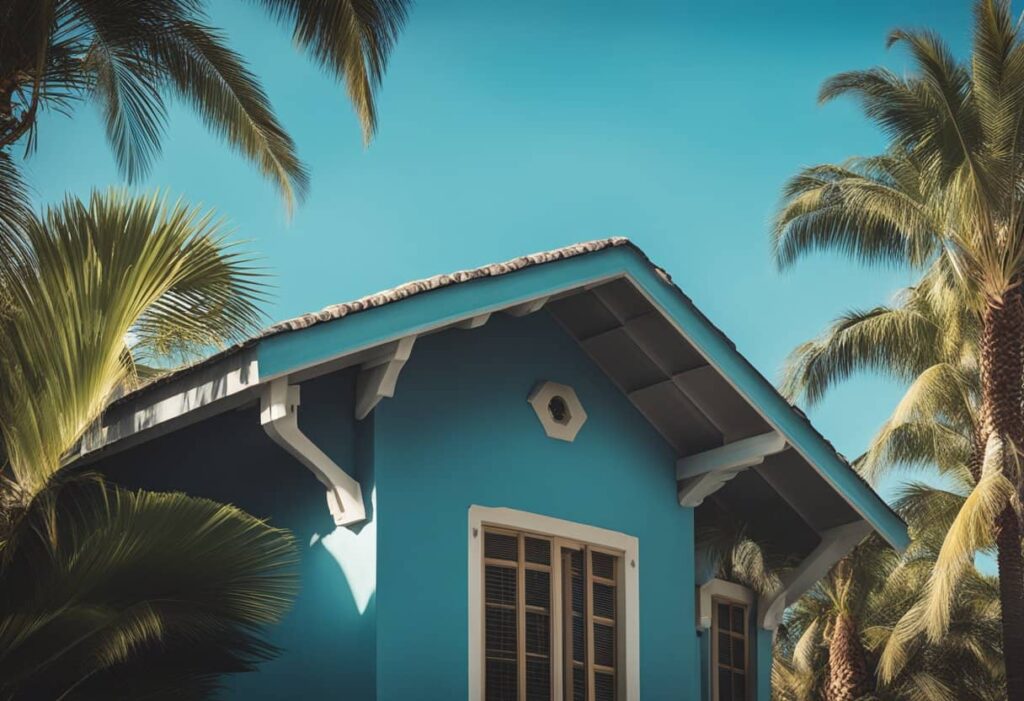Determining the best roof shape in Florida requires an understanding of the state’s unique climatic challenges. Florida’s weather patterns, noted for frequent hurricanes, high winds, and heavy rainfalls, necessitate roofing that offers resilience and durability. The best roof shape in Florida is one that can effectively reduce wind resistance and facilitate water runoff, thus mitigating potential damage from severe weather conditions.

Sloped roofs, specifically those with a pitch that is not too steep nor too shallow, perform well under Florida’s environmental stresses. A gentle slope allows for efficient water drainage while reducing the likelihood that winds will cause uplift. Moreover, the incorporation of additional structural features, such as hurricane straps, can further enhance the roof’s stability against high winds.
It is important for homeowners to consider both the material and shape of their roofing. In Florida, materials like clay tiles or stone-coated steel offer longevity and withstand sun exposure without significantly deteriorating. When these materials are implemented in an aerodynamic roof design, the longevity and safety of the structure are significantly improved, striking a balance between aesthetic appeal and functional necessity.
Types of Roofs Common in Florida

In Florida, the most common roof shapes are designed to withstand the state’s unique weather patterns, including extreme sunshine, heavy rains, and hurricane-force winds. Two of the most prevalent types are tile and metal roofs, renowned for their durability and resilience.
Tile Roofs
Tile roofs in Florida are favored for their longevity and classic aesthetic. They often come in two primary materials:
- Clay Tiles: These are known for their exceptional durability, often lasting well beyond 50 years with proper maintenance. Their natural thermal resistance complements Florida’s hot climate.
- Concrete Tiles: A more cost-effective alternative to clay, concrete tiles can also last for several decades. They provide similar aesthetic appeal and weather resistance.
Key Characteristics of Tile Roofs:
- Longevity: Outlasts many other materials with a lifespan of 25 to 50+ years.
- Weather Resistance: Greatly withstands Florida’s harsh sun, rain, and even hurricane conditions.
- Maintenance: Requires minimal care, though improper installation can lead to issues.
Metal Roofs
Metal roofs are gaining popularity in Florida as a new type of roof due to their durability and energy efficiency. Common metal roof types include:
- Aluminum: Resistant to salt corrosion, making it ideal for coastal areas.
- Steel: Often coated with zinc to enhance rust resistance; robust and versatile.
Key Characteristics of Metal Roofs:
- Longevity: Can last up to 50 years, sometimes more, with proper care.
- Energy Efficiency: Reflects solar radiant heat, which can reduce cooling costs.
- Storm Resistance: Offers excellent protection against extreme weather events.
Both tile and metal roofs come in a variety of shapes including the popular barrel, flat, and S-shapes for tiles, and standing seam, corrugated, and metal tile for metal roofs. These allow homeowners to choose the style that best suits their specific needs and preferences.
Evaluating Roof Longevity in Florida

In Florida, the longevity of roofing materials is a crucial consideration due to the state’s unique weather conditions, including intense sun, high humidity, and the potential for hurricanes. Homeowners typically prefer roofing materials that balance durability and cost-effectiveness. Here below we’ve mentioned the life span of different types of roofs
Metal Roofs: Metal roofing stands out with its durability and energy efficiency. It reflects solar radiant heat, which can lower cooling costs, and is capable of withstanding high winds. On average, metal roofs can last 40-70 years.
Composite Shingles: Composite shingles, designed to resemble natural slate or wood, offer a lifespan of 30-50 years. They are synthetic and engineered for longevity and resistance to Florida’s climate.
Asphalt Shingles: As the most common roofing material nationwide, asphalt shingles are favored for their cost-effectiveness. In Florida, however, their lifespan is on the lower end, typically 15-30 years, due to the harsh weather conditions.
Wood Shingles: Wood shingles provide a classic aesthetic with a lifespan of 25-30 years. However, they may require more maintenance compared to other materials due to susceptibility to decay.
Choosing the best roof for Florida involves considering these materials’ lifespans and how well they can hold up against Florida’s demanding climate. While metal roofs may offer the best longevity, the selection is often also influenced by aesthetic preference and budget.
| Material | Average Lifespan (Years) | Notable Qualities |
|---|---|---|
| Metal | 40-70 | Durable, energy-efficient |
| Composite | 30-50 | Mimics natural materials |
| Asphalt | 15-30 | Cost-effective |
| Wood | 25-30 | Rustic appearance |
Homeowners should also remain vigilant about changes in the Florida Building Code to ensure their roofing choices remain compliant.
Considerations for Choosing the Right Roof Shape

When selecting the right roof shape for a Florida home, homeowners must consider climate resilience, energy efficiency, and maintenance requirements. Roof shapes significantly impact how a structure withstands weather and regulates temperature.
Advantages of Sloped Roofs
Sloped roofs are a predominant choice in Florida due to their ability to facilitate water runoff, which is especially beneficial during the state’s heavy rainfalls. They come in various styles, like gable and hip roofs, known for their excellent wind resistance—a critical feature for hurricane-prone areas.
- Wind resistance: Hip roofs, with slopes on all four sides, are structurally more resistant to high winds compared to gable roofs.
- Water drainage: Sloped designs prevent water accumulation, reducing the risk of leaks and water damage.
Flat Roof Viability
While flat roofs offer a modern aesthetic and are cost-effective, they are less common in Florida. They can be suitable for Florida’s climate if properly designed with robust water drainage systems and regular maintenance.
- Energy efficiency: Flat roofs can support solar panels, which may improve a home’s energy efficiency.
- Maintenance: They require more frequent inspections and maintenance to prevent water pooling and subsequent damage.
The choice between a sloped or flat roof in Florida hinges upon an individual’s priorities for durability, energy conservation, and aesthetic preference.
Best Roof Practices and Maintenance
When it comes to choosing the best type of roof in Florida, one must prioritize both the shape and the material. The most suitable roofs for Florida’s harsh weather conditions are typically made of metal or stone-coated steel. They offer enhanced durability and can reflect solar radiant heat, potentially reducing cooling costs.
For maintenance, homeowners should:
- Regularly Inspect: A bi-annual inspection can identify issues like cracks or rust, especially after hurricane season.
- Keep it Clean: Debris and mildew can compromise a roof’s integrity. Regular cleaning helps prevent decay and discoloration.
- Trim Overhanging Branches: This minimizes debris accumulation and reduces the risk of damage during storms.
Metal roofs require minimal maintenance, but it’s crucial for longevity to:
| Maintenance Task | Frequency |
|---|---|
| Inspection | Bi-annual |
| Debris Removal | After storms |
| Gutter Cleaning | Bi-annual |
| Professional Assessment | Every 10 years |
In Florida, the climate demands a roof that can withstand not only intense heat but also high winds and heavy rains. Homes with steep, narrow pitches tend to be less ideal as they can catch wind easily, while low-slope or flat roofs could collect water and debris, leading to faster wear.
In conclusion, proper maintenance combined with an appropriate choice in roofing material and design is the best strategy for ensuring a long-lasting, resilient roof in the Sunshine State.
Why Choose Rabbit Roofing as Your Tampa Roofing Contractor?
At Rabbit Roofing – best Tampa Roofing Contractor, we prioritize exceptional service and craftsmanship. With decades of local expertise, we understand Tampa’s unique weather and building regulations. Our skilled team handles all aspects of roofing, using top-quality materials and techniques. We are committed to clear communication, honest pricing, and timely completion. With 24/7 emergency service and a strong track record, we’re the trusted choice for reliable roofing solutions in Tampa. Join our many satisfied customers who rely on us for durable, high-quality roofs.

